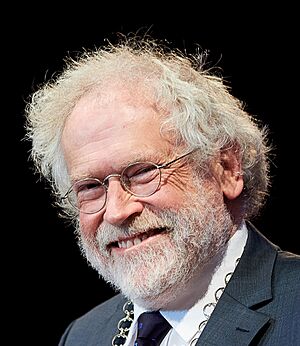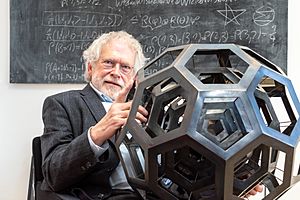Anton Zeilinger facts for kids
Quick facts for kids
Anton Zeilinger
|
|
|---|---|

Zeilinger in 2019
|
|
| Born | 20 May 1945 Ried im Innkreis, Austria
|
| Alma mater |
|
| Known for |
|
| Awards |
|
| Scientific career | |
| Fields | Physics, Quantum mechanics |
| Institutions |
|
| Thesis | Neutron depolarization measurements on a Dy-single crystal (1972) |
| Doctoral advisor | Helmut Rauch |
| Doctoral students |
|
Anton Zeilinger (born May 20, 1945) is a famous Austrian physicist. He won the Nobel Prize in Physics in 2022. He is known for his amazing work with quantum mechanics, especially quantum entanglement.
Zeilinger is a professor at the University of Vienna. He is also a senior scientist at the Institute for Quantum Optics and Quantum Information. This institute is part of the Austrian Academy of Sciences. His research mainly focuses on the strange and wonderful world of quantum entanglement.
In 2007, he received the first Isaac Newton Medal for his groundbreaking work. This award recognized his contributions to understanding quantum physics. In October 2022, he shared the Nobel Prize in Physics with Alain Aspect and John Clauser. They were honored for their experiments with entangled photons. Their work helped prove important ideas in quantum information science.
Contents
Early Life and Education
Anton Zeilinger was born in 1945 in Ried im Innkreis, Austria. He studied physics at the University of Vienna from 1963 to 1971. He earned his doctorate degree from the University of Vienna in 1971. His thesis was about "Neutron depolarization measurements."
In 1979, he qualified as a university lecturer. This means he was approved to teach at a university level.
Anton Zeilinger's Career
In the 1970s, Zeilinger worked as a research assistant. He was at the Vienna Atominstitut. Later, he became a researcher at the Massachusetts Institute of Technology (MIT).
In 1979, he became an assistant professor back at the Atominstitut. He also became a university professor at the Vienna University of Technology that same year.
From 1981 to 1983, Zeilinger returned to MIT as a physics professor. Between 1980 and 1990, he taught at several universities. These included the Vienna University of Technology, the Technical University of Munich, and the University of Innsbruck.
He was also the scientific director of the Institute for Quantum Optics and Quantum Information in Vienna. He held this role from 2004 to 2013. In 2013, he became a professor emeritus at the University of Vienna. This means he retired but kept his title. From 2013 to 2022, he was the president of the Austrian Academy of Sciences.
Since 2006, Zeilinger has been a leader at the Institute of Science and Technology Austria. He even helped start this important project. In 2009, he created the International Academy Traunkirchen. This academy helps talented students in science and technology. He is also a big fan of Hitchhiker's Guide To The Galaxy. He even named his sailboat "42" after a famous number from the book!
Amazing Quantum Research
What is Quantum Teleportation?
Zeilinger was one of the first scientists to achieve quantum teleportation. This is not like teleporting people in movies! Instead, it's about transferring quantum information from one place to another. He showed how to teleport a "qubit," which is a basic unit of quantum information.
He later improved this work. He managed to teleport qubits over long distances. One experiment sent quantum information 144 kilometers between two Canary Islands. Quantum teleportation is very important for future quantum computers.
Entanglement Swapping: Teleporting Entanglement
Entanglement swapping is like "teleporting" an entangled state. An entangled state means two particles are linked, no matter how far apart they are. If you measure one, you instantly know something about the other.
Zeilinger's group was the first to show this experimentally in 1998. This discovery helps us understand how quantum information can be shared.
Entanglement with Many Particles
Anton Zeilinger also helped open up the field of "multi-particle entanglement." This is when more than two particles are entangled together. In 1990, he worked with Daniel Greenberger and Michael Horne. They studied the entanglement of more than two qubits.
Their work led to the GHZ theorem. This theorem shows how quantum physics is very different from our everyday world. It proves that our normal ideas about reality don't work at the quantum level. In 1999, Zeilinger's team showed this experimentally. They proved entanglement beyond two particles for the first time.
Quantum Communication and Computing
In 1998, Zeilinger's group was the first to use quantum entanglement for quantum cryptography. This is a super-secure way to send secret messages. They used entangled photons (tiny particles of light).
In 2005, he also worked on optical quantum computation. This is about using light to build quantum computers. His team performed the first "one-way quantum computation."
Zeilinger's team also worked on sending entanglement over long distances. They did experiments across the Danube river in Vienna. Then they expanded to distances across the city. They even sent entanglement 144 km between two Canary Islands. This showed that quantum communication with satellites is possible! His big dream is to put sources of entangled light onto a satellite in orbit.
New Types of Entangled States
Zeilinger and his group have created many new types of entangled states. For example, they developed a way to create "polarization-entangled photon pairs." These are used in many labs around the world. They also showed how to entangle the "orbital angular momentum" of photons. This opened up a whole new area of research.
Macroscopic Quantum Superposition
Zeilinger is also interested in seeing if quantum mechanics can apply to larger objects. In the 1990s, he started experiments with atoms. He found ways to control atomic beams very precisely.
In 1999, he started working with very large molecules called fullerenes. These are much bigger than atoms. He successfully showed "quantum interference" for these molecules. This means these larger objects can also behave like waves, which is a quantum effect. This opened up a very active field of research.
In 2005, his group studied the quantum physics of tiny mechanical parts. In 2006, they showed how a tiny mirror could cool itself using light pressure.
Fundamental Quantum Tests
Zeilinger's team has performed many important tests of quantum mechanics. In 1998, they did a final test of Bell's inequality. This experiment helped confirm that quantum mechanics is correct. It showed that particles can be connected in ways that classical physics cannot explain.
His group also tested theories proposed by Anthony James Leggett. These theories tried to explain quantum effects in a different way. Zeilinger's experiments showed that these theories were incorrect. This further proved the strange and unique nature of quantum mechanics.
Neutron Interferometry
Anton Zeilinger's earliest work was on "neutron interferometry." This research laid the foundation for his later discoveries.
He worked with his supervisor, Helmut Rauch, at the Vienna University of Technology. They did experiments with neutrons. One of his first experiments confirmed a basic prediction of quantum mechanics. It showed that a neutron's "spin" changes sign when it rotates. He also created the first experiment showing "coherent spin superposition" of matter waves. This means a neutron can be in two spin states at once.
He continued his work at MIT with Clifford Shull. Later, he built an interferometer for very cold neutrons. He also built a double-slit experiment for neutrons. This experiment showed that even single neutrons can act like waves.
Honours and Awards
International Prizes
- Nobel Prize in Physics (2022, with John Clauser and Alain Aspect)
- Heisenberg Medal of the Heisenberg Society (2022)
- Micius Quantum Prize (2019)
- Cozzarelli Prize in Physical and Mathematical Sciences (2018)
- John Stewart Bell Prize (2017)
- Wolf Prize in Physics (2012, with Alain Aspect and John Clauser)
- Grand Merit Cross with Star of the Order of Merit of the Federal Republic of Germany (2009)
- Inaugural Isaac Newton Medal (2008)
- Quantum Electronics Prize (2007)
- King Faisal International Prize in physics (2005)
- Descartes Prize (2004)
- Klopsteg Memorial Award (2004)
- Order Pour le Mérite for Arts and Sciences (2000)
- European Optics Prize (1996)
Austrian Prizes
- Grand Decoration of Honour in Gold with Sash for Services to the Republic of Austria (2024)
- Austrian Decoration for Science and Art (2001)
See also
 In Spanish: Anton Zeilinger para niños
In Spanish: Anton Zeilinger para niños


